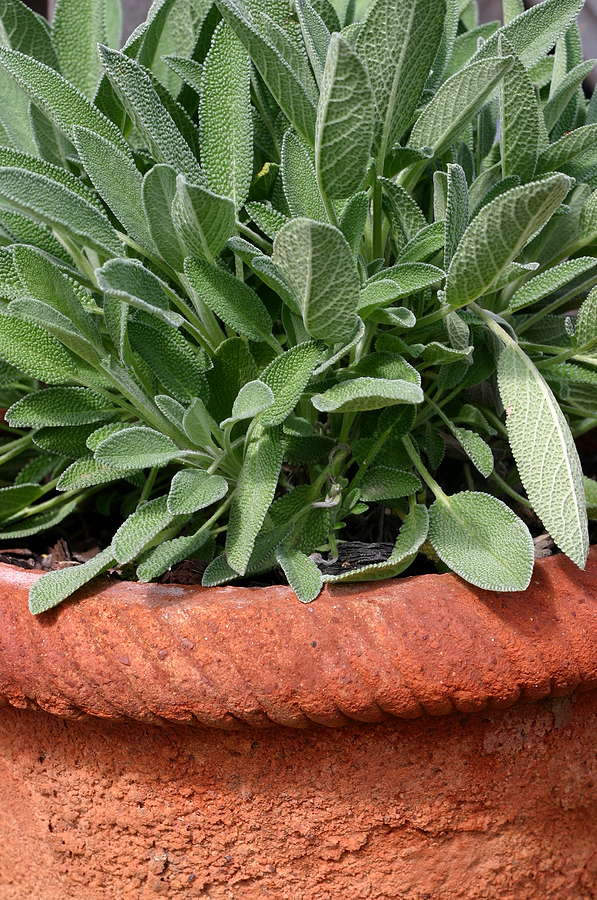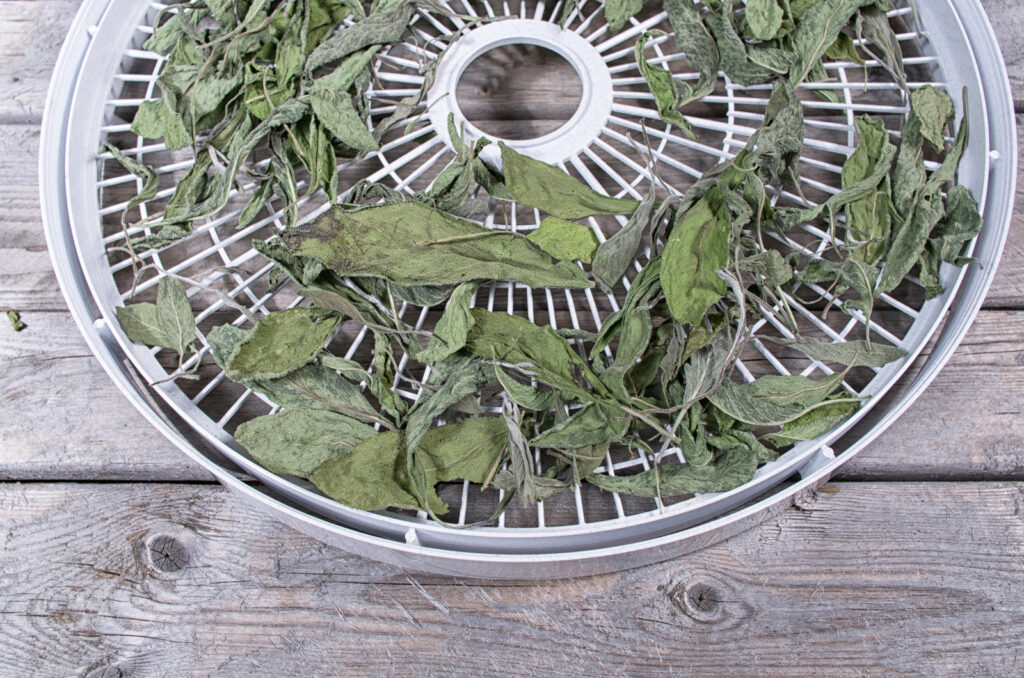You can learn how to grow sage in minutes. Sage is an herbaceous perennial herb that is easy to grow in most sunny gardens. In the kitchen, sage has an aggressive pungent aroma and flavor which is often described as camphor-like and musty. Sage is commonly used in dishes containing pork, cheese, and beans, and it can be blended with cheese or cottage cheese to make a sandwich spread. Getting sage started in the garden or indoors in a pot is easy.
Here is your complete guide to growing sage.
Where to plant sage
- Best location: Plant sage in full sun; sage will tolerate partial shade but the flavor of leaves will be diminished.
- Soil preparation: Grow sage in well-drained soil. Sandy loam is best but sage will grow in very average soil as well. Sage prefers a soil pH of 6.0 to 6.7.
Articles of interest:
- How to Grow Herbs
- How to Start an Herb Garden
- Best Herbs for Container Growing
- Herbs for Cool Season Growing
- Grow 20 Herbs for Cooking

When to plant sage
- Seed starting indoors: Start sage seed indoors as early as 6 to 8 weeks before the average last frost date.
- Transplanting to the garden: Transplant seedlings out to the garden after the last frost when the soil has warmed.
- Outdoor planting time: Sow sage seed in the garden in late spring about or after the last frost. Sow seed shallowly.
- Cuttings: Take cuttings or divide older plants in spring or fall.
How to plant sage
- Sow sage seeds ¼ inch deep.
- Thin sage seedlings or space transplants 20 inches apart or more. Space rows 20 to 24 inches apart.
- Grow one or two sage plants for cooking; grow 4 to 6 plants for preserving.
Sage companion plants
- Grow sage with chives and calendula, also with cabbage, carrots, strawberries, and tomatoes.
- Sage is said to deter cabbage-family pests such as imported cabbage worms and root maggot flies.
- Sage flowers attract bees and other beneficial insects to the garden.
- Some say sage will stunt the growth of cucumbers and has a negative effect on onions.
Watering sage
- Sage requires regular even watering until established.
- Once established keep sage on the dry side.
- Sage is easily killed by overwatering or soggy soil.
- Lack of water will improve the flavor of sage, but avoid allowing the plant to wilt from lack of moisture.
- Overhead watering may cause serious mildew problems.
Feeding sage
- Sage grows best in sandy-loam soil but does not require regular feeding.
- Give sage a side dressing of compost tea twice during the growing season.
Sage care
- Divide sage plants every three years to maintain vigor.
- Mulch around sage with aged compost or chopped leaves in very hot regions; mulch will slow soil moisture evaporation.
- Mulch in severe winter regions to keep roots from freezing.
Pruning sage
- For the best flavor, prune away flower stems before they bloom.
- Trim or cut plants back in autumn to renew foliage for the following season.
- Prune sage for shape after flowering.
- Sage will become woody and decline after several years and should be replaced.

Container growing sage
- Sage can be container-grown as an annual. Grow sage in a pot at least 8 inches deep and wide.
- Over-winter container-grown sage in a protected place, an unheated garage, or a patio.
Winter growing sage
- Where winters are cold, mulch over plants to help sage survive through the winter. Sage does not grow well where winters are wet or springs are moist and cold.
Sage pests and diseases
- Sage has no serious pest problems.
- Sage has no serious disease problems but can suffer root rot if grown in a place that is too damp or shady.
- Maintain good air circulation between sage plants to stem disease problems.
How to harvest sage
- Snip off individual leaves as needed during the growing season. Sage requires 75 to 80 days from sowing to reach maturity.
- Prune or trim sage with a garden pruner. Harvest leaves from well-established plants. Trim away 6 to 8 inches of leafy growth twice during the growing season to keep sage bushy.
- Harvest only the upper third of the plant; it will generate new growth for harvest in the same season.
Sage in the kitchen
- Flavor and aroma: Sage has a lemony, camphor-like fragrance and taste.
- Leaves: Leaves are eaten fresh in salads and cooked in omelets, fritters, soups, marinades, sausages, and poultry stuffing. Cook sage with beef, pork, fish, lamb, and poultry. Add dried leaves to artichokes, tomatoes, asparagus, carrots, squash, corn, potatoes, eggplant, snap beans, leeks, onions, Brussels sprouts, cabbage, oranges, lemons, garlic, cheese, and shell beans. Blend sage with butter or soft cheeses.
- Sage leaves are also used in making sausage, herb vinegar, and herb butter.
- Dried leaves: The flavor of sage intensifies with drying; one teaspoon of dried sage equals one tablespoon of chopped fresh sage.

Preserving and storing sage
- Refrigeration: Fresh leaves will keep 2 or 3 days in the refrigerator wrapped in a paper towel placed in a plastic bag.
- Drying: Hang bunches of sage by their stems in a well-ventilated, shaded, warm place; drying will take 2 to 5 days. The longer sage dries the more flavor it will lose.
- Freezing: Sage leaves can be frozen in an airtight freezer container or bag.
- Storing: Store dried leaves in an airtight container for up to six months.
Sage home medicinal use
- Sage is used internally for colds, diarrhea, indigestion, anxiety, tension, coughs, irregular menstruation, and menopause
- Sage is used externally for baths, facial tonic, facial steam rinse, or gargle. Rub leaves on teeth to whiten.
- Sage medicinal uses include infusion, traditional tincture cider vinegar tincture, syrup, elixir, ointment, salve, cream, foot soak, bath herb, infused oil, honey, and liniment.
- Do not take large doses of sage for more than two weeks.
- Sage contains estrogen, pregnant women should use sage carefully.
Sage propagation
- Seed: Stratify seeds for several weeks then sow indoors. Seeds germinate in about 14 days. From seed, it can take a year for sage to reach usable size.
- Cuttings: Sage can be started from stem cuttings taken from new growth in late spring or summer or from divisions in spring or fall. Use 4 to 6-inch cuttings; dip the cut ends in a rooting hormone to help root formation.
- Division: Divide older established plants in spring or fall with a spade.
- Layering: Sage can be propagated by layering during the growing season. Place soil over an herbaceous section of the branch; roots will grow from the buried section..
Sage varieties to grow
- Black currant sage( S. microphylla): broad, deep green leaves with a currant-like fragrance.
- Blue sage( S. clevelandii): tall to 4 feet; substitute for garden sage.
- Clary sage( S. sclarea): tallest sage to 5 feet tall and wide; very large leaves
- Garden sage(Salvia officinalis): hardy perennial to 30 inches; gray-green leaves and violet flowers. Cultivars include ‘Dwarf’ that grows to 12 inches tall; ‘Berggarten’ which produces large silvery gray leaves but no flowers; ‘Albiflora’ with narrow leaves and white flowers; ‘Rubriflora’ with red flowers.
- Salvia officinalis‘Albiflora’: garden sage with white flowers.
- Golden sage( S. o. ‘Aurea’): the compact plant grows to 18 inches tall with variegated golden and green foliage.
- Greek sage( S. fruitcosa): large, gray-green leaves, strongly aromatic.
- Fruit sage (S. dorisiana)
- Pineapple sage( S. elegans): dark green leaves with strong pineapple fragrance, not hardy; grows 24 to 42 inches tall; brilliant red flowers.
- Purple sage( S. o. ‘Purpurea’): purple-red edged leaves.
- Spanish sage (S. lavandulifolia)
- Tricolor sage( S. o. ‘Tricolor’): finely wrinkled, variegated leaves of green, white, purple, red, and pink.

Get to know sage
- Botanical name and family: Salvia Officinalis and species (Lamiaceae—mint family)
- Origin: Mediterranean
- Type of plant: Sage is a hardy perennial shrub.
- Growing season: Summer
- Growing zones: Sage grows in zones 4 to 8; it thrives in hot or cool dry environments.
- Hardiness: Sage is resistant to both cold and heat; its cold hardy to -30°
- Plant form and size: Sage is a hardy rounded perennial shrub–often woody–that can grow 12 to about 24 inches tall and sometimes as large as 36 inches tall and wide, a few varieties may grow taller. Sage stems elongate into upright flowering spikes in late spring. There are dwarf varieties that grow to 1 foot high with proportionately smaller leaves.
- Flowers: Sage has tubular flowers that are commonly bluish-lavender, red, or bicolor (depending on the variety) and form whorls on tall spikes.
- Bloom time: Sage flowers in spring and summer.
- Leaves: Sage has elongated, oval- to lance-shaped, wrinkled, grayish-green leaves from 1 to 5 inches long with a coarse, pebbly surface. Several sage varieties have variegated leaves: purple, yellow, green, or green and white.
Also of interest:
- Anise
- Anise Hyssop
- Arugula
- Basil
- Bay
- Bee Balm
- Borage
- Calendula
- Caraway
- Catnip
- Chamomile
- Chervil
- Chives
- Cilantro-Coriander
- Clary
- Costmary
- Cress
- Dill
- Fennel, Sweet
- Horseradish
- Hyssop
- Lavender
- Lemon Balm
- Lemongrass
- Lemon Verbena
- Lovage
- Marjoram
- Mint
- Nasturtium
- Oregano
- Parsley
- Perilla
- Rosemary
- Sage
- Salad Burnet
- Savory
- Scented Geranium
- Shiso
- Sorrel
- Stevia
- Sweet Cicely
- Tarragon
- Thyme
Related articles:
Best Herbs for Container Growing
Planning the Home Fruit Garden
Garden Planning Books at Amazon:
- Vegetable Garden Almanac & Planner
- Kitchen Garden Grower’s Guide Vegetable Encyclopedia
- Vegetable Garden Grower’s Guide
- Tomato Grower’s Answer Book



